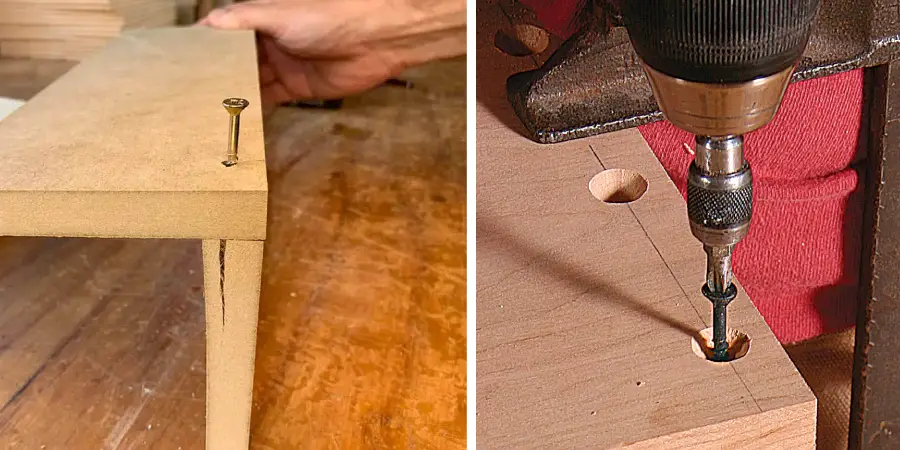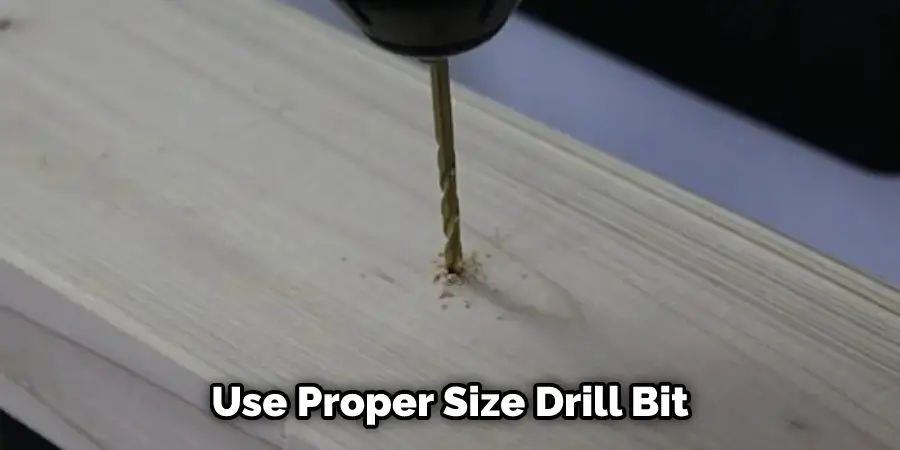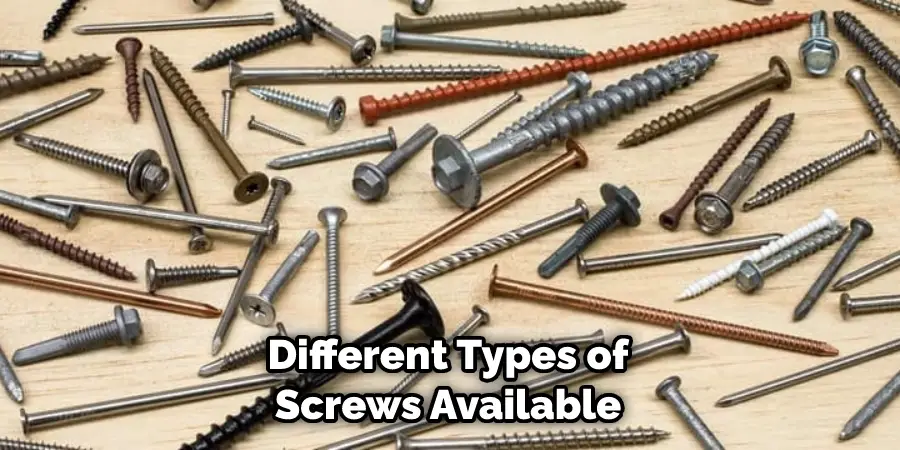It can be frustrating when you try to put a screw into wood, and it suddenly splits! Unfortunately, this often happens because the wood is not properly prepared before the screw is inserted. In this blog post, we will give you some tips on how to prevent wood from splitting when screwing.

Summary: When screwing a piece of wood together, it’s important to use a screw that is the right size and shape for the hole. If the screw is too big, the wood will split when you screw it in. If the screw is too small, the wood may not hold the screw in place and it could come loose later on.
Why Should You Prevent Wood from Splitting when Screwing?
When you’re driving a screw into wood, it’s important to be careful and prevent the wood from splitting. Splitting occurs when the screw applies too much pressure to the wood fibers, causing them to break apart. While a small amount of splitting may not seem like a big deal, it can weaken the overall structure of your project and make it more susceptible to damage. In addition, splitting can also cause the screw to become loose over time, making it more likely to fall out.
To avoid these problems, simply take a few precautionary measures when driving screws into wood. First, drill a pilot hole that is slightly smaller than the diameter of the screw. This will help to reduce the amount of pressure on the wood fibers. In addition, use screws that have sharp, tapered points; these are less likely to cause splitting than flat-headed screws. By taking these simple steps, you can help to ensure that your projects stay strong and durable for years to come.
9 Tips to Follow on How to Prevent Wood from Splitting When Screwing
1. Use the Proper Size Drill Bit
Using the proper size drill bit is important when working with wood. If the drill bit is too small, it can cause the wood to split. If the drill bit is too large, it will cause the hole to be too big, and the screw will not hold properly.

2. Pre-drill the Hole
It is also important to pre-drill the hole before inserting the screw. This is especially important when working with harder woods. By pre-drilling the hole, you can prevent the wood from splitting.
3. Use a Countersink Bit
A countersink bit will create a small depression in the wood around the hole for the screw head, which will help to prevent the wood from splitting. Be sure to drill the hole slightly deeper than the countersink bit so that the screw head will be slightly below the surface of the wood.
4. Use a Brace Bit
A brace bit is a drill bit with a small guide at the tip that helps keep the bit straight as you drill. It’s especially helpful when working with smaller pieces of wood that are more likely to split.
5. Choose the Right Type of Screw
There are many different types of screws available, each with its advantages and disadvantages. Choosing the right type of screw for the job at hand is important to prevent wood splitting.
For example, deck screws are designed to resist corrosion and can be driven in with less force than other screws, making them ideal for outdoor projects.

6. Insert the Screw Slowly and Carefully
When inserting the screw, it is important to do so slowly and carefully. This will help to ensure that the screw doesn’t split the wood. To do this, start by inserting the screw into the pilot hole.
7. Drill in at an Angle
Drilling in at an angle will also help to prevent the wood from splitting. When drilling straight down into the wood, there is a greater chance that the wood will split. Drilling in at an angle greatly reduces the risk of splitting.
8. Use Clamps When Possible
When working with wood, it is always best to use clamps when possible. This will help to keep the pieces of wood together and will also help to prevent the wood from splitting.
9. Use Marine Grade Epoxy Putty
Marine grade epoxy putty can be used to fill in any cracks or holes in the wood before you start screwing. This will help to prevent the wood from splitting when the screw is inserted.
That’s it! You’ve now learned how to prevent wood from splitting when screwing. By following these tips, you’ll be able to avoid this problem altogether.

The Top Five Ways to Prevent Wood from Splitting When Screwing
Wood is a versatile material that can be used for various purposes, from building furniture to creating art. However, wood is also susceptible to splitting, which can ruin your project’s aesthetic and make it structurally unsound. You can take a few simple steps to prevent your wood from splitting when screwing. First, ensure that you use the correct size drill bit for your screws. Second, predrill your holes to create a starter hole for your screw.
Third, use a countersink bit to create a shallow recess for your screw head. Fourth, use an impact driver or power drill to drive in your screw. And finally, if you’re still having trouble, try using shorter screws or tapered plugs. By following these simple steps, you can avoid those frustrating splits and ensure that your projects are both beautiful and structurally sound.
How to Choose the Right Screw for the Job
Screws are one of the most versatile and commonly used fasteners. They come in various sizes, materials, and shapes and can be used for everything from hanging pictures to assembling furniture. But with so many options available, how do you know which screw is right for the job? Here are a few factors to consider:
Size:
The first thing to think about is the size of the screw. Both diameter and length measure screws, and you’ll need to ensure that the screw you choose is appropriate for the thickness of the material you’re working with. If you’re unsure, err on the side of a longer screw rather than a shorter one.

Material:
The next thing to consider is the material of the screw. Different screws are made from different materials, each with advantages and disadvantages. For example, screws made from stainless steel are very strong and resistant to corrosion, but they’re also more expensive than other options. Ultimately, the best material for your project will depend on your budget and the job’s specific requirements.
Shape:
Another important factor to consider is the shape of the screw. Most screws have a traditional “flat head” shape, but there are also Phillips head screws and Robertson screws, among others. The type of head you choose will depend on your tool and your personal preferences.
By considering all of these factors, you can be sure to choose the right screw for the job. Then, with a little careful planning, you’ll be able to tackle any project confidently. Keep reading for more information about how to prevent wood from splitting when screwing.
What Kind of Drill Bit do I Need?
When it comes to drilling holes, a wide variety of drill bits are available to choose from. The type of drill bit you need will depend on the material you’re drilling into and the hole size you need to create. For example, if you’re drilling into soft wood, you can use a standard spade bit. However, if you’re drilling into harder materials like concrete or brick, you’ll need to use a masonry bit. Regarding size, drill bits are available in a range of diameters, from small 1/4″ bits to large 1″ bits.
The size you need will depend on the size of the hole you need to create. In general, it’s best to start with a smaller bit and then work your way up to the next largest size if needed. With so many different types and sizes of drill bits available, it’s important to choose the right one for the job at hand. By taking into consideration the material, you’re drilling and the size of hole you need to create, you can be sure to select the perfect drill bit for the task at hand.
How to Prevent Your Wood Screws from Splitting the Wood
Even the most experienced carpenters occasionally have a wood screw split into the wood they are driving it into. This is not only frustrating, but it can also cause serious damage to your project. Thankfully, there are a few simple tips you can follow to help prevent this from happening. First, always use a pilot hole when possible. This will give the screw somewhere to grip and help prevent it from splitting the wood.
Second, be careful not to over-tighten the screw. If you tighten it too much, the pressure can cause the wood to split. Finally, ensure you use the right size screw for the job. Using a screw that is too large for the piece of wood you are working with is one of the most common causes of splits. Following these simple tips can help ensure that your next project goes off without a hitch.
How to Stop Wood from Splitting When Drilling ?
The splitting of wood is a common problem when drilling, especially when using larger drill bits. Fortunately, one can use a few techniques to prevent the wood from splitting when drilling. The first and most important step is to use a drill bit that is designed for woodworking. Wood drill bits often have a steeper angle and smaller point angle than metal drill bits, which helps prevent splitting.
One can also use a pilot hole before drilling a larger hole. The pilot hole should be slightly smaller in diameter than the drill bit to be used. This helps to guide the drill bit and prevent it from wandering, which can cause the wood to split. Another technique is to use a backer board behind the piece of wood being drilled.
The backer board helps to support the wood and prevent splitting. Finally, one can use a clamp to hold the piece of wood being drilled in place. This helps prevent the wood from moving around while drilled, which can lead to splitting. Using these techniques can prevent the wood from splitting when drilling and ensure a successful project.
Will Linseed Oil Stop Wood from Cracking ?
Linseed oil is a natural oil that is commonly used as a finish for wood products. It is believed that applying linseed oil to wood can prevent it from cracking or warping over time. However, it’s important to note that linseed oil will not completely stop wood from cracking.
Wood naturally expands and contracts with changes in humidity and temperature, which can cause it to crack over time. Linseed oil can help to slow down this process by penetrating the wood and making it more moisture-resistant. This can help to prevent the wood from drying out and becoming brittle.
Applying linseed oil to wood is a simple process that involves wiping it onto the surface with a clean cloth. It’s important to allow the oil to dry thoroughly between coats and to apply multiple coats for the best results. However, linseed oil should not be relied upon as a cure-all solution for preventing the wood from cracking.
How Do You Dry Wood So It Doesn’t Crack?
Drying wood is a process that should be approached with patience and care to avoid cracking. The main reason wood cracks during the drying process is uneven moisture levels. To dry wood so it doesn’t crack, the wood needs to be dried slowly and evenly. Sealing the wood ends to control moisture loss and avoid uneven drying is recommended.
One way to do this is to apply a coat of wax or a commercial wood sealer on the ends of the wood. Additionally, air circulation is important, as stagnant air promotes warping and cracking. Stacking the wood to allow air to circulate around it can help achieve even drying. It’s important to avoid exposing the wood to direct sunlight or heat, as this intensifies moisture loss and can cause cracking.
Finally, monitoring the wood moisture levels using a moisture meter is recommended. Once the wood has reached the desired moisture content, it can be used without fear of cracking. Overall, drying wood so it doesn’t crack requires a combination of slow, even drying, careful monitoring, and environmental control.
Does Oiling Wood Prevent Splitting?
Oiling wood can provide numerous benefits and can help to protect the wood from splitting. Wood naturally contains a certain amount of moisture, which can cause it to crack and split when exposed to dry conditions or changes in temperature. Applying oil to wood can help to repel moisture and reduce the rate at which wood dries out. This can help to prevent the wood from cracking and splitting.
Additionally, oiling wood can help to provide a protective layer, making it more resistant to environmental factors such as sunlight and heat. This can help to prevent the wood from drying out too quickly and can extend its lifespan.
However, it’s important to note that oiling wood is not a foolproof method for preventing splitting. Different types of wood may react differently to oil, and the effectiveness of the oil will depend on the specific conditions to which the wood is exposed. Additionally, wood that has already started to split may not be able to be saved by oiling alone.
Conclusion
By following these tips, you can help prevent your wood from splitting when you are trying to insert screws into it! Careful drilling, using the right type of screw, and taking your time will go a long way in preventing this headache-inducing problem. Thanks for reading our post about how to prevent wood from splitting when screwing.

